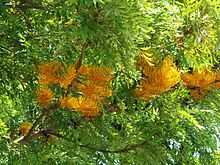Grevillea robusta
| Grevillea robusta | |
|---|---|
 | |
| Scientific classification | |
| Kingdom: | Plantae |
| (unranked): | Angiosperms |
| (unranked): | Eudicots |
| Order: | Proteales |
| Family: | Proteaceae |
| Genus: | Grevillea |
| Species: | G. robusta |
| Binomial name | |
| Grevillea robusta A.Cunn. ex R.Br. | |

Grevillea robusta, commonly known as the southern silky oak or silky oak, or Australian silver oak, is the largest species in the genus Grevillea of the family Proteaceae. It is not closely related to the true oaks, Quercus. It is a native of eastern coastal Australia, in riverine, subtropical and dry rainforest environments receiving more than 1,000 mm per year of average rainfall.
Description
It is a fast-growing evergreen tree, between 18–35 m (59–115 ft) tall, with dark green delicately dented bipinnatifid leaves reminiscent of a fern frond. It is the largest plant in the Grevillea genus, reaching diameters in excess of 1 m (3 ft). The leaves are generally 15–30 cm (6–12 in) long with greyish white or rusty undersides.
Its flowers are golden-orange bottlebrush-like blooms, between 8–15 cm (3–6 in) long, in the spring, on a 2–3 cm long stem and are used for honey production. Like others of its genus, the flowers have no petals, instead they have a long calyx that splits into 4 lobes.[1] The seeds mature in late winter to early spring, fruiting on dark brown leathery dehiscent follicles, about 2 cm long, with one or two flat, winged seeds.
Uses
Before the advent of aluminium, Grevillea robusta timber was widely used for external window joinery, as it is resistant to wood rot. It has been used in the manufacture of furniture, cabinetry, and fences. Owing to declining G. robusta populations, felling has been restricted.
Recently G. robusta has been used for side and back woods on guitars made by Larrivée and others, because of its tonal and aesthetical qualities.
Cultivation
When young it can be grown as a houseplant where it can tolerate light shade, but prefers full sun as it grows best in warm zones. If planted outside, young trees need protection on frosty nights. Once established it is hardier and tolerates temperatures down to −8 °C (18 °F).[2] It needs occasional water but is otherwise fairly drought-resistant.
Grevillea robusta is often used as stock for grafting difficult-to-grow grevilleas.
Care needs to be taken when planted near bushland as it can be weedy.
The tree has been planted widely throughout the city of Kunming in south-western China forming shady avenues.
This plant has gained the Royal Horticultural Society's Award of Garden Merit.[3]
G. robusta is also grown in plantations in South Africa[4] and can also be grown alongside maize in agroforestry systems.[5]
Toxicity and allergic reactions
The flowers and fruit contain toxic hydrogen cyanide.[6] Tridecylresorcinol in G.robusta is responsible for contact dermatitis.[7]
-

Silky Oaks planted in a tea garden
-

Trunk bark
-

Leaf
-

Flowering branches
-

Flowers
-

Unripe seed pods
-

Leaves and dry seed pods
-

Dry seed pod
-
Seed pod and seeds
-

Flowering branches
References
- ↑ RHS A-Z encyclopedia of garden plants. United Kingdom: Dorling Kindersley. 2008. p. 1136. ISBN 1405332964.
- ↑ "Garden Guides: Silkoak".
- ↑ "Grevillea robusta AGM". RHS Plant Finder. Royal Horticultural Society. Retrieved 27 July 2013.
- ↑ Overseas-grown Australian Timber Species Retrieved on 8 December 2008
- ↑ Jackson, N. (2000). "Tree pruning as a means of controlling water use in an agroforestry system in Kenya". Forest Ecology and Management 126 (2): 133–152. doi:10.1016/S0378-1127(99)00096-1.
- ↑ Everist, S.L., Poisonous Plants of Australia, Angus & Robertson, 1974.
- ↑ Menz, J., Rossi, R., Taylor, W.C, Wall, L., Contact dermatitis from Grevillea'Robyn Gordon', Contact Dermatitis, Vol. 15, Iss. 3, pp 126-131, Apr 2006
External links
| Wikimedia Commons has media related to Grevillea robusta. |
- Grevillea robusta fact sheet on Forest, Farm, and Community Tree Network (FACT Net)
- Germplasm Resources Information Network: Grevillea robusta
- Plants of Hawaii (images): Grevillea robusta
